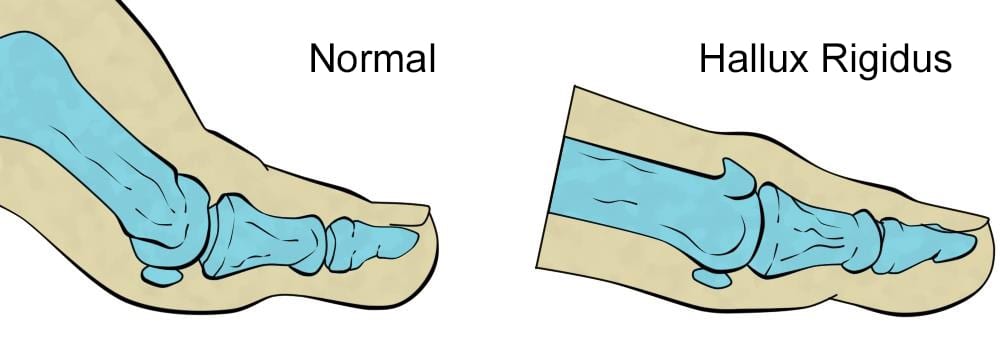HALLUX RIGIDUS
If you suffer from Hallux Rigidus, don’t hesitate to Schedule an appointment with one of our orthopedic specialists.
What Is Hallux Rigidus?

Arthritis in the foot most commonly affects the big toe joint, also known as the metatarsophalangeal, or MTP joint. Arthritis in the MTP joint can cause a large amount of pain when walking, as the joint bends the furthest of all the foot joints when taking a step.
As with all joints, the ends of the bones that make up the MTP joint have surfaces covered in smooth cartilage. If the bones lose this cartilage, whether through standard wear and tear over time, or through damage from an injury, the bone ends can rub together, causing painful arthritis. This grind can develop bone spurs on the top of the joint. This further prevents the toe from bending properly while walking, leading to more pain and stiff toe, known as Hallux Rigidus.
Adults between the ages of 30 and 60 years old have the highest risk of developing Hallux Rigidus. Some people in the same demographic have a higher risk than others to develop Hallux Rigidus, though no one explicitly knows why. Toe injuries can damage the articular cartilage and cause slight changes in the anatomy of the toe. These slight variations can affect people differently and may contribute to developing Hallux Rigidus.
What are the Symptoms of Hallux Rigidus?
- Joint Pain in the big toe, especially when walking.
- Swelling around the MTP joint.
- Developing a bump on the top of the foot, near the MTP joint.
- Stiffness in the big toe that makes the toe difficult to move.
Your foot and ankle specialist will examine the foot to properly diagnose Hallux Rigidus. They may request X-rays to show the exact location of any bone spurs or other signs of degradation in the joint space and cartilage of the big toe joint.
What Is a Cheilectomy?
Foot and Ankle Specialists perform a Cheilectomy procedure to remove Bone Spurs from the joint of the Big toe, curing the condition known as Hallux Rigidis.
Foot and Ankle Specialists define Cheilectomy as an operation of the MTP (metatarsophalangeal) joint. This joint connects where the big toe bends and attaches back to the foot. This procedure involves making an incision on the skin and removing excess bone with the aid of orthopedic tools that shave away bone spurs.
Generally, bone spurs form at the top of the MTP joint, but surgeons may also remove bone spurs on the sides of the joint during a cheilectomy.
Orthopedic surgeons and podiatrists perform this outpatient foot surgery under local anesthesia as either open surgery or a minimally invasive procedure with a smaller incision.
What Are The Reasons For A Cheilectomy?
Common factors associated with big toe bone spurs include:
- Arthritis: A degeneration of cartilage. Over time, the cartilage wears down and exposes the bone. Bone spurs then start to form over the exposed areas.
- Trauma: Such as stubbing or injuring the toe.
- Repetitive impacts on the foot, as during sports, may lead to small fractures and inflammation. A condition described as turf toe can also develop. Eventually, these issues may cause the growth of bone spurs around the big toe joint.
As a consequence of arthritis in the big toe, Hallux rigidus can form, often preceded by hallux limitus, a lesser form of arthritis in the big toe where the joint stays somewhat stiff, but not as painful as hallux rigidus.
Often, before considering a cheilectomy, patients can manage the pain and inflammation of hallux limitus and hallux rigidus themselves by applying heat and cold to the area, taking anti-inflammatory medications, and/or wearing orthotic shoes. When these measures fail, you may discuss surgery with your Foot and Ankle Specialist.

